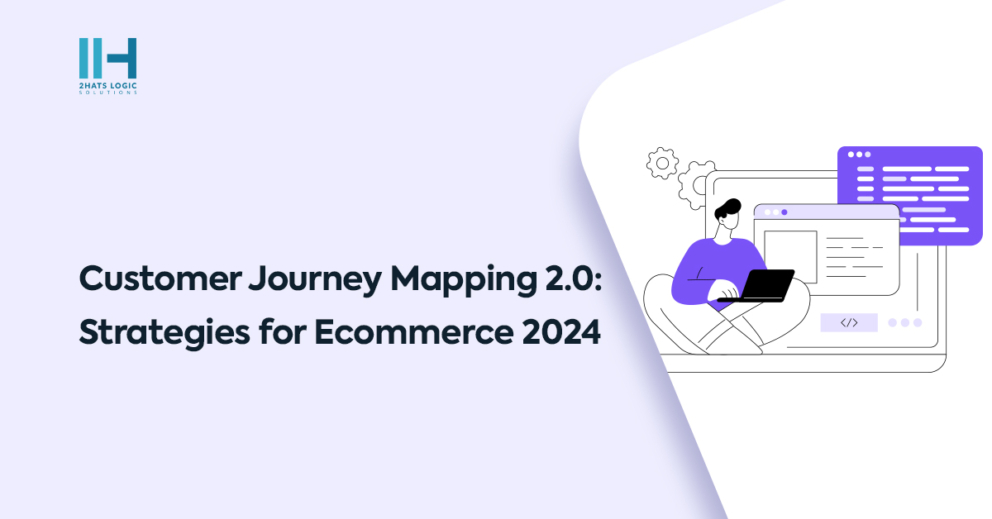Greetings! I'm Aneesh Sreedharan, CEO of 2Hats Logic Solutions. At 2Hats Logic Solutions, we are dedicated to providing technical expertise and resolving your concerns in the world of technology. Our blog page serves as a resource where we share insights and experiences, offering valuable perspectives on your queries.

Understanding a customer’s journey from discovery to purchase is a critical and intricate task. It’s comparable to deciphering a complex map, filled with various routes and hidden insights. Every interaction, click, and decision shapes this journey, moulding the overall e-commerce customer experience and influencing purchasing choices. The major factor in this is the customer experience in ecommerce stores which is significant in shaping brand perception.
In this blog, let’s explore the concept of customer journey mapping, its benefits, stages, and the process of building a customer journey map to gain insight into how a customer makes decisions that ultimately lead to conversion optimization.
What is Customer Journey Mapping
Customer Journey Mapping is a strategic process where businesses analyse and visually represent the various touchpoints and interactions that customers experience across different stages of their buying journey.
E-Commerce Customer Journey Mapping Strategies
Take a closer look at the core strategies integral to effective Customer Journey Mapping:
Understanding Customer Touchpoints
Touchpoints cover all customer interactions, from viewing ads to post-purchase support. It’s essential to map and analyze these interactions, as they shape customer views and influence decisions. Focusing on the most influential touchpoints helps optimize them to enhance the overall shopping experience.
Establishing Customer Personas
Customer personas are semi-fictional characters that represent various user types within a target demographic. By creating these personas based on real data about customer behaviours and preferences, a business can tailor the journey to address each group uniquely. This helps in personalizing marketing efforts and improving product offerings.
Mapping the Buyer’s Journey
The journey typically includes stages such as Awareness, Consideration, Decision, and Post-Purchase. At every stage, it’s important to note what the customer is looking for, feeling, and the obstacles they might encounter.
Analyzing the Path to Purchase
Upon mapping the journey, issues that customers may encounter become more apparent. These could be anything from a complicated checkout process to inadequate product information. Addressing these issues is vital to creating a smoother path to purchase, thereby encouraging sales and fostering customer satisfaction.
Leveraging Data and Feedback
A journey map should not be static; it should evolve as more customer data and feedback become available. Utilizing analytics tools to track customer behaviour and actively seeking feedback can provide ongoing insights.
Integrating Across Channels
Customers expect a unified brand experience, whether they are shopping from a mobile device, a desktop, or through social media platforms. All channels used by a business must be integrated to deliver a seamless experience. Synchronization between different departments like marketing and sales is also key to maintaining a cohesive customer journey.
Testing and Iteration
A journey map is a tool for continuous improvement. By conducting A/B testing and other forms of experimentation, an e-commerce business can discern what works best for its customers. It’s a process of trial and error that, over time, refines the customer’s journey and solidifies brand loyalty.
Advantages of Customer Journey Mapping
Take a look at the advantages of customer journey mapping that helps to understand customers at a deep level:
1. Know your customers deeply
This provides a comprehensive understanding of customers’ interactions and behaviours throughout the buying process, including online shopping behaviour. This helps to identify pain points and opportunities for improvement. Ensures a smoother and more satisfying experience for customers navigating the digital marketplace.
2. Advanced Customer Experience
By identifying and addressing pain points along the online store customer journey, businesses can enhance the overall customer experience, leading to increased satisfaction and loyalty.
3. Targeted Marketing
Mapping the customer journey allows businesses to tailor their marketing efforts to specific stages of the buying process. This maintains that messages and promotions resonate with customers at the right time and place.
4. Higher Conversion Rates
By optimizing the customer journey, businesses can streamline the buying process and remove obstacles that may prevent customers from completing their purchases. This will ultimately lead to higher conversion rates.
5. Data-Driven Insights
Customer journey mapping generates valuable data and insights that businesses can use to make informed decisions about product development, marketing strategies, and resource allocation.
6. Alignment Across Teams
Customer journey mapping encourages collaboration and alignment across different organisational departments. This ensures that everyone works towards the common goal of improving the customer experience.
If you experience challenges with e-commerce optimization, let our experts guide you towards a steady customer journey.
Say Goodbye to Slow, Vulnerable Websites. Embrace the Power and Security of Laravel:
Schedule a free 30-minute consultation
Ecommerce Customer Journey Stages
The ecommerce customer journey is vital for online retail success. Understanding its stages offers valuable insights for optimizing strategies. Let’s explore each phase and its influencing factors.
Awareness
At the Awareness stage, customers first become familiar with your brand, products, or services. This may occur through various channels such as social media, search engines, ads, or word-of-mouth. The aim is to capture the attention of potential customers and introduce them to what you offer. Showcasing your social media like Instagram and Facebook on your online store helps customers become aware of your brand.
Consideration
During the Consideration stage, once customers are aware of your brand. Then they will begin to evaluate whether your offerings meet their needs or solve their problems. They might compare your products or services with competitors, read reviews, and seek more information to make an informed decision. Providing detailed product descriptions, customer reviews, and comparison tools can assist customers at this stage.
Acquisition
In the Acquisition stage, customers decide to purchase from you. They could put things in their cart, check out, and finish the transaction. To reduce friction, a simple and intuitive shopping experience is essential. Incentives such as discounts, free shipping, or limited-time offers can also motivate customers to make a purchase. Using email reminders can help reduce cart abandonment.
Service
After the purchase is made, customers enter the Service stage where they may require assistance or support. This could involve tracking their order, resolving any issues or concerns, or seeking help with product usage or troubleshooting. Providing excellent customer service and support is crucial for building trust and loyalty with customers.
Loyalty
The Loyalty stage focuses on nurturing long-term relationships with customers to encourage repeat purchases and advocacy. This involves engaging with customers post-purchase through personalized communications, loyalty programs, exclusive offers, and rewards. Businesses can turn satisfied customers into loyal brand advocates by delivering exceptional experiences and consistently meeting or exceeding expectations.
Stage | Customer Emotions | Customer Actions |
| Awareness | Curiosity | Researching and exploring different options |
| Consideration | Apprehension | Reading reviews, comparing prices and features |
| Acquisition | Confidence | Placing an order, making a payment |
| Service | Satisfaction | Seeking help |
| Loyalty | Overall Evaluation | Providing feedback, recommending, repeat purchases |
Trends of ecommerce customer journey mapping
AI-Powered Personalization
Artificial Intelligence and machine learning algorithms can analyze vast amounts of customer data to personalize the shopping experience, recommending products and content tailored to individual preferences.
Voice Commerce
Voice-enabled devices and virtual assistants are reshaping how customers interact with Ecommerce platforms, providing hands-free shopping experiences and voice-activated product searches.
Augmented Reality (AR)
AR technology allows customers to visualize products in real-world environments before making a purchase, enhancing the online shopping experience and reducing the need for returns.
Blockchain
Blockchain technology can be used to create transparent and secure supply chains, providing customers with assurance regarding product authenticity and ethical sourcing.
Conclusion
In conclusion, customer journey mapping is a strategic imperative for e-commerce success in 2024. Understanding the intricacies of customer interactions, from awareness to loyalty, provides invaluable insights for optimizing every touchpoint of the online shopping experience, making it crucial for any e-commerce development agency.
Moreover, the advantages of customer journey mapping extend far beyond improved conversion rates. It fosters a deep understanding of customers, leading to enhanced customer experiences, targeted marketing efforts, and data-driven insights, all of which are pivotal for an e-commerce development agency to thrive in today’s competitive market.
By following the key steps outlined for effective customer journey mapping, businesses, including e-commerce development agencies, can not only identify pain points but also seize opportunities for innovation and differentiation in the competitive e-commerce landscape.
FAQ
How can businesses optimize the e-commerce customer journey?
By employing customer journey mapping, businesses can gain comprehensive insights into customer behaviour, enhance the overall experience, and drive engagement and loyalty.
What is customer journey mapping?
Customer journey mapping is a strategic process where businesses analyze and visually represent the various touchpoints and interactions that customers experience across different stages of their buying journey.
Why is customer journey mapping important for e-commerce?
Customer journey mapping is crucial for e-commerce as it provides insights into customer behaviours, needs, and pain points throughout the buying process.
How can customer journey mapping benefit businesses?
Customer journey mapping allows businesses to identify pain points and opportunities for improvement in the online shopping experience. It enables targeted marketing efforts and enhances customer satisfaction.
What are the key stages of the e-commerce customer journey?
The key stages of the e-commerce customer journey include awareness, consideration, acquisition, service, and loyalty. Each stage represents a different phase of the customer's interaction with the brand, from initial discovery to post-purchase engagement.
How can businesses implement customer journey mapping effectively?
To implement customer journey mapping effectively, businesses should define objectives, identify customer personas, map touchpoints, understand customer emotions, gather data, create a customer journey map, and analyze and identify pain points for improvement.

Related Articles








